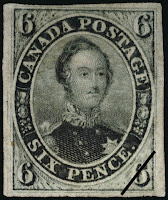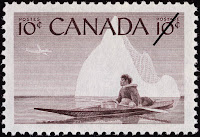BY: SERENA YPELAAR
I recently moved to the Northwest Territories to complete my MMSt summer internship, so I’ve been sending a lot of postcards home. And of course, postcards require stamps, which gave me an idea: let’s look back at Canadian history through postage stamps! So, in honour of Canada’s 150th anniversary on July 1st, I’ve taken a look through Canada's stamp collections and chosen a few interesting ones to examine how commemorative stamps have changed over time.
EARLIEST STAMPS
The “Threepenny Beaver” – 1851
Among his many achievements, Sir Sandford Fleming (Fleming College’s namesake) designed the Province of Canada’s first postage stamp in 1851. Rather than the typical portrait of Queen Victoria used in Britain at the time, Fleming selected the beaver as the image – the first official stamp anywhere to depict an animal rather than a monarch. Fleming’s choice referred to the beaver’s centrality in the Canadian economy (via the Fur Trade) and helped solidify its status as the hardworking animal that we so frequently cite as a symbol of Canada.
 |
| Source. |
Victoria, Albert, and … Cartier? – 1850s
A 6-pence stamp featuring HRH Albert, the Prince Consort, was engraved by Alfred Jones and released in May 1851. This stamp actually preceded the June 1851 introduction of Queen Victoria herself, on a 12-pence stamp – also engraved by Jones. These two stamps were the second and third official stamps issued by the Province of Canada, and the inclusion of the monarchy has continued up to present day.
A 6-pence stamp featuring HRH Albert, the Prince Consort, was engraved by Alfred Jones and released in May 1851. This stamp actually preceded the June 1851 introduction of Queen Victoria herself, on a 12-pence stamp – also engraved by Jones. These two stamps were the second and third official stamps issued by the Province of Canada, and the inclusion of the monarchy has continued up to present day.
 |
| Prince Albert stamp. Source. |
 |
| Queen Victoria stamp. Source. |
Interestingly, Jacques Cartier was also featured on an 1859 stamp, despite not being a monarch. His inclusion in the 1859 stamp series demonstrates his perceived value as an early European explorer of the New World. Since then, explorers such as Martin Frobisher have also been celebrated on Canadian stamps.
“We Hold A Vaster Empire Than Has Been” – 1898
Leading up to Confederation and beyond, the face of the British monarch was still customary on many Canadian stamps. At Christmas of 1898, however, another imperial design emerged and has since become one of the most iconic stamps in Canadian history. Hon. William Mulock, then Postmaster General of Canada, hoped to prompt interest in fixing a uniform postage rate for the whole British Empire. He thus issued a stamp that illustrated the breadth of the British Empire.
 |
| The phrase "We Hold a Vaster Empire Than Has Been" comes from Welsh poet Sir William Morris' "A Song of Empire", written for Queen Victoria's Diamond Jubilee in 1897. Source. |
L’Abitation de Québec & Quebec Military History – 1900s
1908 saw the commemoration of 300 years since Samuel Champlain founded Québec. The colony of New France of course played a significant part in the history of Quebec and of Canada as a whole – yet King Edward VII’s consent was still required to deviate from the portrait of a monarch. The illustration on the Quebec stamp is adapted from Champlain’s own sketch, and the archaic French from his diaries is also present.
One of the most famous images in Canadian history, this 50th anniversary commemoration was issued in 1917, followed by a joint portrait of Sir Wilfrid Laurier and Sir John A. Macdonald in 1927. The rest of this collection comprised stamps picturing the Canadian Parliament buildings; a map of Canada; and some of the country’s most prominent statesmen, including Hon. Thomas D’Arcy McGee, Robert Baldwin, and Sir Louis Lafontaine.
CONTEMPORARY THEMES
Nature, Sports, and Health
Apart from the monarchy and prominent figures in Canadian history, Canadian stamps also moved toward showcasing popular natural sites, such as the Rocky Mountains and other landscapes. Technological advances also became the norm on Canadian postage stamps by the 1930s and 40s; these demonstrated Canada’s progress, innovation, and production to the world. Accomplishments in health and education were also prominent in contemporary history since the Second World War, as Canada’s social development took the spotlight.
Sporting achievements came more and more into use as the twentieth century progressed, with Stanley Cup victories and Olympic feats growing more popular on Canadian stamps.
1908 saw the commemoration of 300 years since Samuel Champlain founded Québec. The colony of New France of course played a significant part in the history of Quebec and of Canada as a whole – yet King Edward VII’s consent was still required to deviate from the portrait of a monarch. The illustration on the Quebec stamp is adapted from Champlain’s own sketch, and the archaic French from his diaries is also present.
 |
| "L'abitation de Quebec". Source. |
Similarly, Generals Montcalm and Wolfe, known for their opposing leadership and for their deaths at the Battle of the Plains of Abraham in 1759, were commemorated in a dual postage stamp, with permission likewise granted by the King.
The Fathers of Confederation – 1917
The Fathers of Confederation – 1917
One of the most famous images in Canadian history, this 50th anniversary commemoration was issued in 1917, followed by a joint portrait of Sir Wilfrid Laurier and Sir John A. Macdonald in 1927. The rest of this collection comprised stamps picturing the Canadian Parliament buildings; a map of Canada; and some of the country’s most prominent statesmen, including Hon. Thomas D’Arcy McGee, Robert Baldwin, and Sir Louis Lafontaine.
 |
| Source. |
Of course, Canada Post has commemorated even more historical individuals since these earliest examples. Other historical figures, from military Generals like Sir Isaac Brock to leaders such as Louis Riel, would also be featured in the following decades.
CONTEMPORARY THEMES
Nature, Sports, and Health
Apart from the monarchy and prominent figures in Canadian history, Canadian stamps also moved toward showcasing popular natural sites, such as the Rocky Mountains and other landscapes. Technological advances also became the norm on Canadian postage stamps by the 1930s and 40s; these demonstrated Canada’s progress, innovation, and production to the world. Accomplishments in health and education were also prominent in contemporary history since the Second World War, as Canada’s social development took the spotlight.
Similarly, a stamp collection in the 1950s depicted outdoor activities and sportsmanship; the series contained depictions of Indigenous populations which seem to observe their cultural activities through a third-person, distanced colonial perspective that romanticizes their way of life.
 |
| "Inuit Hunter", issued in 1955, presents a romanticized view of Inuit in Canada's north. Source. |
 |
| Lake Placid Olympic Winter Games stamp, 1980. Source. |
Canadian Art & Heraldry
Prominent Canadian artists like the Group of Seven have also been featured in Canadian stamps, with artists such as Lawren Harris, Tom Thomson, and J.E.H. MacDonald receiving commemorative stamps in their honour.
Prominent Canadian artists like the Group of Seven have also been featured in Canadian stamps, with artists such as Lawren Harris, Tom Thomson, and J.E.H. MacDonald receiving commemorative stamps in their honour.
 |
| Part of the Group of Seven commemorative stamp series, depicting Tom Thomson's "The Jack Pine". Source. |
In the 1960s Canada Post also issued a series on the Canadian provinces, with one stamp featuring each province, its crest, and its provincial flower.
 |
| As a proud Ontarian, I had to share our provincial stamp from 1964! Source. |
In 1970, Canada Post featured Inuit artist Kenojuak Ashevak’s print “The Enchanted Owl” on a stamp to mark 100 years since the Northwest Territories entered Confederation. This print and its corresponding stamp is certainly one of my favourites, as I’ve always loved Kenojuak’s beautiful work.
 |
| "Centennial of the Northwest Territories", featuring Kenojuak Ashevak's "The Enchanted Owl". Source. |
Around the same time, artists such as John McCrae, the poet who wrote “In Flanders Fields” have also been remembered, with new artists and musicians featured as the years pass.
And finally, with all the commemorative stamps that are coming out these days, it wouldn’t really be Canada without a Vimy Ridge commemoration, would it? Our attention has always been directed toward our few military victories - and this year is no exception, since it’s the 100th anniversary of the Canadian victory at Vimy in WWI. The Vimy 100 series is being issued jointly with France.
I hope you enjoyed looking back through some old stamp collections! Do you have any favourite postage stamps or collections of your own?
Visit the Canadian Postal Archives here.


No comments:
Post a Comment
Note: only a member of this blog may post a comment.